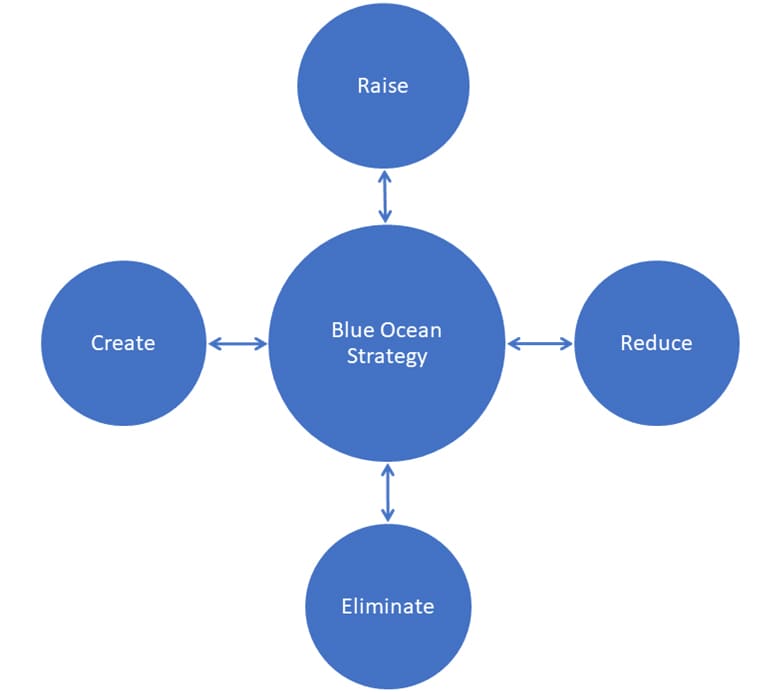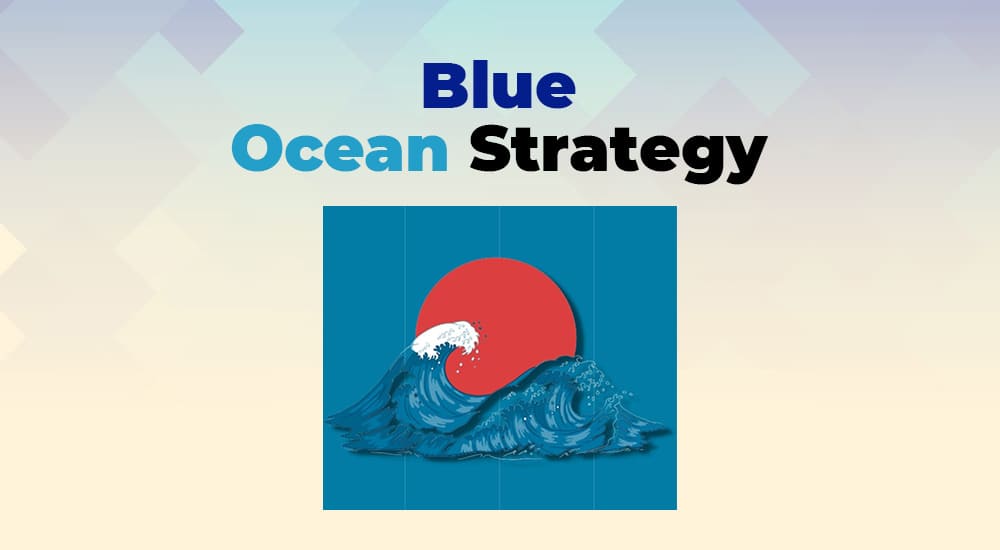Definition: The blue ocean represents an unexplored market, and blue ocean strategies help businesses tap into this marketplace. Blue ocean markets offer massive opportunities, allowing businesses to cater to a new and unrealized market.
With blue ocean products and services, customers are not aware of their requirements or unmet demand. The creation of blue ocean products or services is considered innovative because already-existing red ocean businesses overlook these markets as they consider them insubstantial.
Since the market is unexplored in blue ocean strategy, this allows blue ocean companies to set the boundaries of the market and earn massive profits.
Blue ocean business strategies are focused on creating products and services for an unrealized market. Some blue ocean products and services have their origins in expanding the red ocean market. However, the core principles for blue oceans remain the same: catering to untapped market space.
Find, Develop and Launch Blue Ocean Strategies
Blue ocean strategy becomes a necessity when supply outperforms the demand or when businesses have no or limited opportunities for growth. In this case, they search for new products to take advantage of the uncontested market.
Businesses can consider the Four Actions Framework strategy to devise buyer value elements in creating a new value curve. This strategy guides the business toward launching a blue ocean initiative.
Kim and Mauborgne recommend asking the following questions to revamp buyer value elements in crafting a new demand or value curve.
The framework poses four key questions.

- Raise: What factors should be expanded to exceed the industry’s standard?
- Reduce: What factors result in competition against other sectors and can be reduced?
- Eliminate: Which factors have the industry competed in for a long time and should stop?
- Create: Which aspects that the business sector has never offered?
This exercise lets businesses examine the competition, and they can search for blue ocean opportunities within their organization and make the shift.
Pros of Blue Ocean Strategy
Below are the benefits of using the blue ocean strategy:
- It helps organizations find undisputed markets and avoid saturated and matured markets.
- It helps break traditional model strategies, i.e., competing with the existing saturated markets and expanding profits and demand by catering to a new and unrealized market.
- Value innovation is crucial in the strategy as it creates new value/demand for consumers and expands the chances of potential growth.
- It helps in recognizing opportunities and encourages the transformation of mindsets.
- Products under the blue ocean strategy follow the concept of differentiation and low cost.
- Implementing the blue ocean strategy offers high payoff possibilities.
Cons of Blue Ocean Strategy
Below are the cons of using this strategy:
- It is challenging to come up with new ideas and capture untapped markets.
- Entering and venturing in the early phase carries a high risk. There is a chance that consumers may not understand the product or services.
- Launching new products requires a lot of patience, trust, preparation, and faith.
- Migrating to a new ocean has high risks as new sharks from the saturated markets may be lured toward the newly created market.
Examples of Blue Ocean Strategy
Meta (Formerly Facebook)
In October 2021, CEO Mark Zuckerberg created a company called Meta and brought Facebook into it. Initially, Facebook started as an innovative blue ocean company that created social networks.
Over a decade later, the social networking industry has become a red ocean, with multiple businesses and organizations offsetting services and products to limited market demand.
With the name change, Meta has acknowledged its product offerings and possibilities being steered in the direction of the “metaverse,” which is interesting and uncharted.
Mark imagines the metaverse to be made up of virtual realities, digital worlds, and holograms that feel like physical realities.
While Meta’s strategy change is still unproven and uncertain, it is still portrayed as a classic red ocean to blue ocean switch.
iTunes
iTunes offered many solutions — from solving the problem of illegal music downloads to catering to the demand for digital, on-demand songs, etc.
iTunes evolved from a market space that was crowded by competition — a red ocean — into a blue ocean by creating a new subset of music sales that permitted artists to earn profits while giving consumers the ability to purchase singles versus albums. The digital music market is now iTunes-dominated.
Netflix
Reed Hastings and Marc Randolph founded the company in 1997. It was the first-ever mail-order DVD rental business company. Netflix introduced a streaming TV model that virtually changed every aspect of modern life. The strategy paid off, and it made Netflix a household name at the level of Walmart or Amazon.
Using Blue Ocean With Existing Strategic Planning Models
A strategic planning process for most companies is tethered to red oceans, and later, businesses integrate blue ocean strategies into their existing strategic planning model. This will help them tap into uncharted blue oceans rather than compete in an existing market space.
Blue Ocean + SWOT
The four core parts of a SWOT analysis are strengths, weaknesses, opportunities, and threats. Blue ocean strategy can utilize strengths to create market niche placement, aim to minimize and remove weaknesses to gain a competitive edge and find ways for business formation, regulations, and other advancements. And finally, this strategy can help develop plans to address risks that can subvert a blue ocean firm’s revenue model.
Blue Ocean + Balanced Scorecard
The balanced scorecard was created to measure future performance and current operating performance.
Balanced scorecards exceed these measures because their objectives and measures are culled from the business unit’s strategy. The scorecard should contain performance drivers and outcomes of these drivers connected in a cause and effect relationship.
Since blue ocean strategies are focused on innovation of value in untapped market spaces, and balanced scorecards are used to implement blue ocean strategies by using buyer utility, price, cost, and adoption.
Conclusion
Blue ocean strategy helps organizations tap into new territories or create new demand in an existing market. Though this strategy is risky and involves high investment, it can provide a high return. Organizations use this strategy when the growth is stagnant, or they need to enter into new markets.
